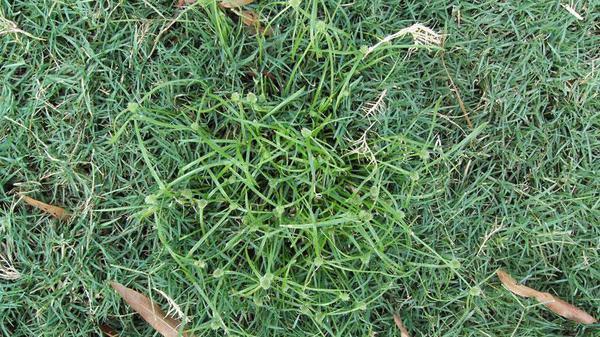Green kyllinga (Kyllinga gracillima). Photo: NC State University 2005
Life cycle
Green kyllinga, also called pasture spikesedge, is a non-native perennial plant in the sedge family.
Growth habit
Produces a network of numerous underground stems (rhizomes) and can root and send out new leaves at each stem node. It has narrow, grass-like leaves. It is often mistaken for nutsedge but unlike nutsedge which grows upright, kyllinga spreads into dense mats and does not have underground tubers. It can handle close mowing.
Reproduction
Prolific seeder
Conditions that favor growth
Sunny, moist areas but can move into shadier, dry spots. Kyllinga can aggressively take over an over-irrigated lawn. Irrigation systems should be adjusted or turned off to take natural rainfall into account and the length of time between water increased to allow the soil to dry out. Water lawns only when necessary.
Management in lawns
Maintain healthy, dense turf that can compete and prevent weed establishment.
Lawn Care
Mechanical management
Hand pulling or using an appropriate weeding tool are the primary means of mechanical weed control in lawns. This is a viable option at the beginning of an infestation and on young weeds. Hand pulling when the soil is moist makes the task easier.
Manage Weeds Without Chemicals
Chemical treatment in lawns
A difficult weed to control, there are no preemergents labeled to control it. Postemergent herbicides can provide management/suppression, but are best used when kyllinga is young and before it forms dense mats.
- Look for the active ingredients: Common Name: Halosulfuron; Trade Name: Sedgehammer and others or Common Name: Sulfentrazone
Herbicide Options for Managing Common Lawn Weeds in Maryland
